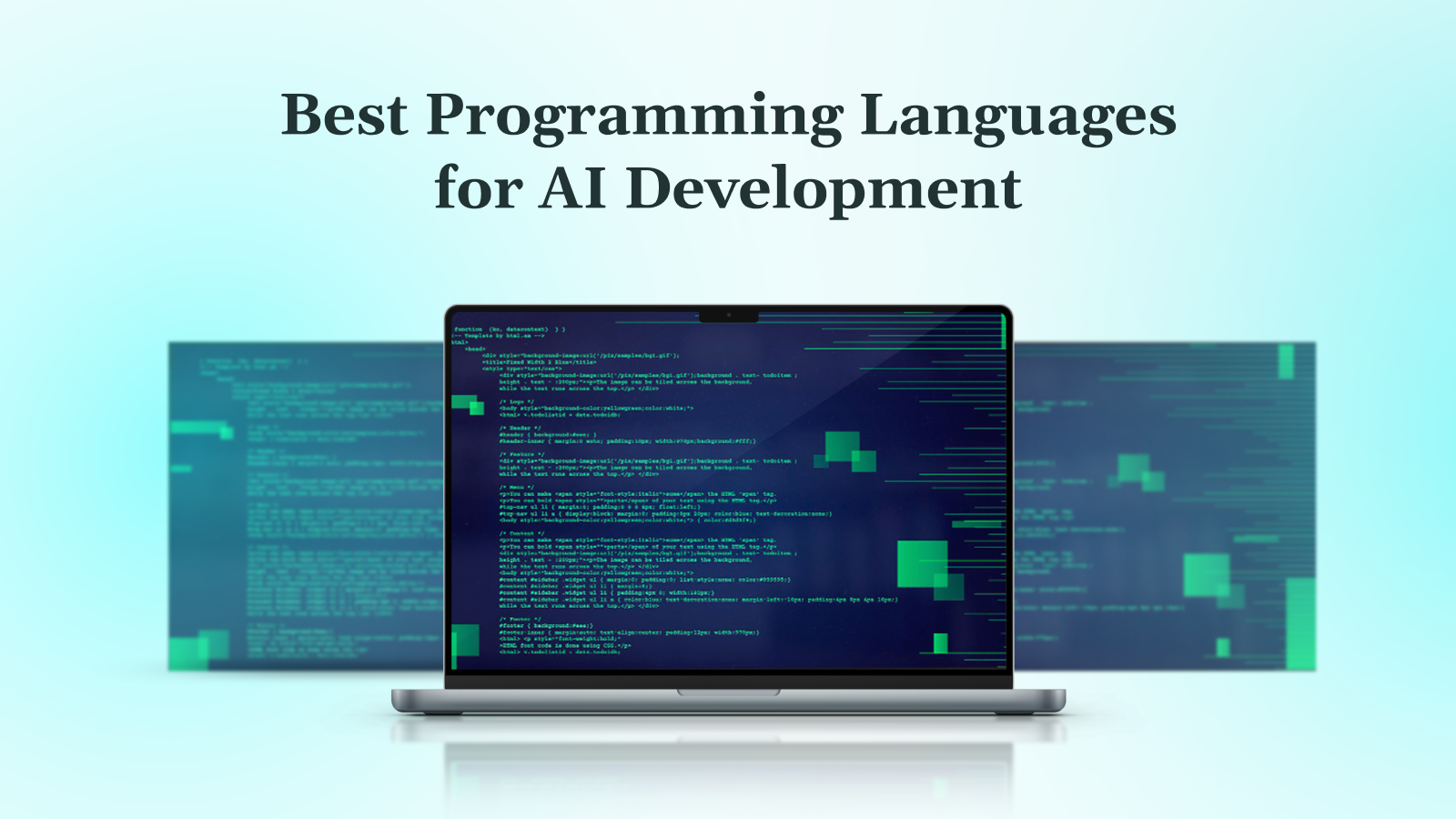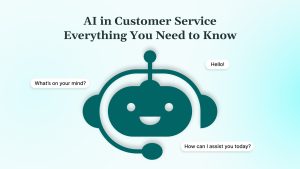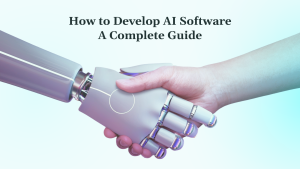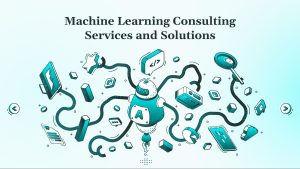Intelligent systems today are expected to do more than process data; they must learn from it, adapt to context, and support critical decision-making at scale. Features like automated approvals, anomaly detection, and real-time recommendations have become foundational in modern software across industries.
At the core of these capabilities lies a strategic engineering decision: the programming language used to build them.
The language you choose directly influences performance, scalability, integration flexibility, and development velocity. A well-aligned choice can reduce time-to-market, simplify access to advanced ML frameworks, and enable seamless collaboration between teams. Conversely, the wrong fit may result in bottlenecks, limited library support, or constrained deployment options.
This guide examines the most effective languages for artificial intelligence development, how they compare, when to use them, and what environments they are best suited for.
Key Takeaways
- The language you choose shapes your entire AI stack, from performance and integration to scalability and time-to-market.
- Python leads for flexibility and ecosystem support, but it is not a one-size-fits-all. Each language brings unique strengths to the table.
- Real-world AI systems are not built in isolation; they often combine languages across components (e.g., Python for models, Go for APIs, JS for the frontend).
- Your use case should drive the decision, not trends. What works for healthcare analytics may not fit a browser-based chatbot or high-frequency trading platform.
- DEVtrust helps companies get this right from the start, combining technical depth with industry insight to deliver AI solutions that scale.
What Are AI Programming Languages?
AI programming languages are selected for their ability to handle data-heavy, logic-driven tasks like training models, processing large datasets, and integrating machine learning frameworks. They go beyond general-purpose coding by offering built-in or easily accessible tools for numerical computing, statistical analysis, and scalable deployment.
Python leads the field due to its rich ecosystem, libraries like TensorFlow and PyTorch make it ideal for both prototyping and production. R excels in statistical modeling, while C++ and Rust are used where speed and memory control are critical. Languages like Java, Julia, and Scala also serve specific use cases in enterprise environments and high-performance computing.
The right AI language helps teams move faster, build smarter, and scale with confidence, making it a strategic choice, not just a technical one.
How to Learn AI Programming Languages
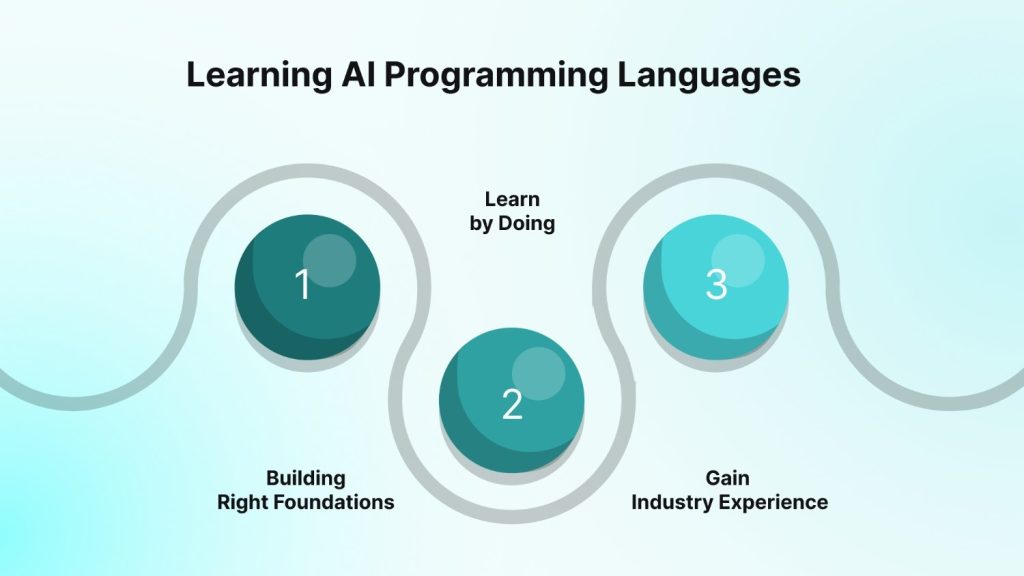
Becoming proficient in AI development requires more than writing code, it involves building a foundation that supports real-world problem-solving and scalable implementation. From mathematical concepts to hands-on practice, here is what it takes to learn effectively:
1. Build the Right Foundations
Before diving into frameworks, focus on the core principles that power intelligent systems.
- Mathematics that matters
Linear algebra, probability, and statistics form the backbone of machine learning. These are essential for building models that classify data, predict outcomes, or detect anomalies in real time. - Strong programming skills
Python is the language of choice for most AI projects due to its readability and mature ecosystem. Tools like TensorFlow, PyTorch, and scikit-learn let developers move fast without sacrificing performance. - Data literacy
Knowing how to clean, structure, and interpret data is just as critical as model design. Without reliable data pipelines, even the most advanced algorithms fall short.
2. Learn by Doing
Conceptual knowledge only gets you so far. Applying AI to real-world use cases, such as training a sentiment analysis model or building a recommendation engine, is what makes skills stick.
- Build small projects first (e.g., chatbots, image classifiers)
- Participate in open datasets and challenges (e.g., Kaggle)
- Try deploying models to understand production concerns
3. Get Industry-Aligned Experience
At DEVtrust, we work closely with teams in sectors like healthcare, education, logistics, and fintech to implement AI/ML solutions that solve practical challenges, maybe automating medical documentation, personalizing learning content, or optimizing logistics tracking.
For those building intelligent systems, we offer:
- Custom AI/ML development and integration services
- Project-based consulting to help internal teams upskill faster
- End-to-end platform builds with analytics, adaptive learning, and real-time data support
Explore how DEVtrust helps organisations not just experiment with machine learning, but deploy it at scale, securely and efficiently.
Top AI Programming Languages
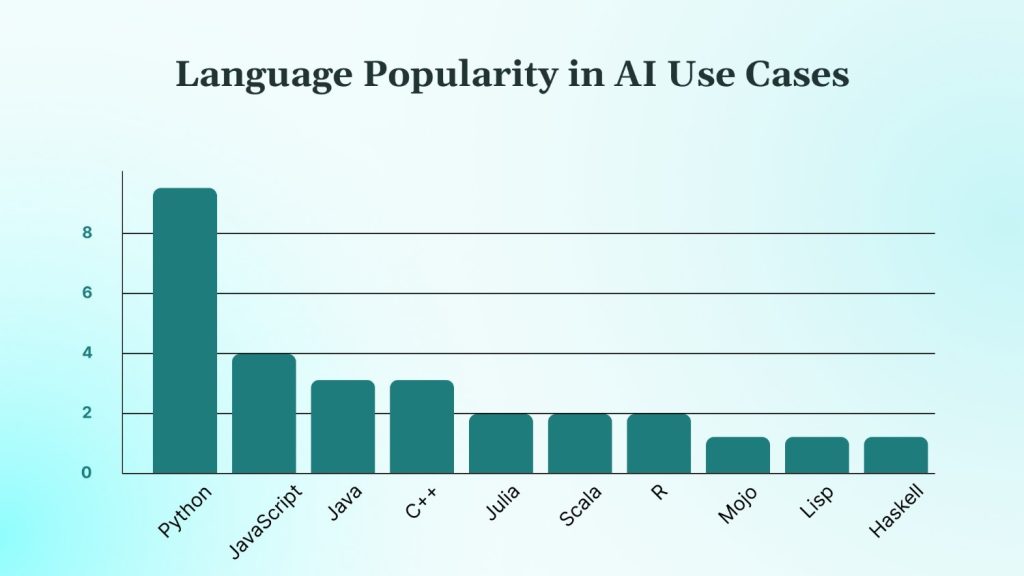
Choosing the right programming language for AI is about precision, performance, and purpose. Real-time analytics, voice-driven healthcare tools, and financial risk models all depend on choosing a language that supports scale, speed, and seamless integration.
Let us break down the most relevant programming languages for AI development today and where they fit best.
1. Python
Python is the undisputed leader in AI programming, and for good reason. It is versatile, easy to learn, and packed with powerful libraries that support every phase of AI development. From prototyping to deployment, Python helps teams move fast without sacrificing quality.
It powers frameworks like TensorFlow, PyTorch, and scikit-learn, which are staples for machine learning and deep learning. Libraries like NumPy and pandas simplify data handling, while Matplotlib makes data visualization intuitive. If you are building recommendation engines, computer vision systems, or generative chat models, Python has the infrastructure to support it.
From building HIPAA-compliant telehealth solutions to predictive financial dashboards, Python is integrated into systems that span across HealthTech, FinTech, and SaaS. With robust support for APIs like Twilio, OpenAI, and Firebase, it helps us deliver scalable and secure AI experiences faster.
Python Use Cases at DEVtrust:
- Cognitive therapy tracking tools (HealthTech)
- AI-driven financial reporting dashboards (FinTech)
- Predictive analytics for operational logistics (SaaS)
Common AI Roles Using Python:
- Machine Learning Engineers
- Data Scientists
- NLP Developers
- Computer Vision Engineers
- AI Researchers
2. R
R is a specialised language for statistical computing and data visualization, particularly valuable in fields that demand in-depth data exploration, hypothesis testing, and model validation. It offers robust support for complex data manipulations through libraries like dplyr, tidyverse, and ggplot2, making it ideal for experimental AI workflows and research.
R also supports machine learning tasks via packages like caret, randomForest, and xgboost. Its strengths lie in exploratory data analysis (EDA), linear and logistic regression modelling, and time series forecasting, making it a staple in academia, bioinformatics, public health, and econometrics.
While not optimised for deployment in large-scale AI systems, R is widely used in early-stage data analysis and prototyping before transitioning models to production in more deployment-friendly languages like Python or Java.
Common AI Roles Using R:
- Data Scientists
- AI Researchers
- Bioinformatics Engineers
- Social Data Scientists
3. Julia
Julia offers the numerical power of C with the intuitive syntax of Python. It is designed for high-performance scientific computing, where speed and precision are critical. Julia compiles to machine code using LLVM, offering substantial performance advantages for compute-heavy AI use cases like differential equation solving, large-scale simulations, and real-time robotics.
Key libraries such as Flux.jl for deep learning and DifferentialEquations.jl for mathematical modelling make Julia a go-to for researchers working on novel algorithms or physical simulations. Its native support for parallelism and distributed computing further enhances its suitability in research environments and fintech simulations.
While adoption is still growing, Julia is becoming increasingly relevant in sectors requiring low-latency performance and mathematical accuracy.
Common AI Roles Using Julia:
- Robotics Engineers
- AI Researchers (optimization & algorithm design)
- Quantitative Analysts
4. Scala
Scala excels at combining functional and object-oriented programming, making it suitable for large-scale machine learning and AI workflows, especially in big data environments. It is tightly integrated with the Apache Spark ecosystem, enabling scalable AI workloads on distributed systems.
Through libraries such as MLlib, Breeze, and Deeplearning4j, Scala supports data preprocessing, model training, and inference across streaming and batch datasets. This makes it valuable for building fraud detection systems, recommendation engines, and real-time analytics pipelines.
Its strong static typing, higher-order functions, and immutability make Scala well-suited for AI systems that require predictable behaviour and long-term maintainability, particularly in finance, telecom, and e-commerce.
Common AI Roles Using Scala:
- Spark Developers
- Machine Learning Engineers
- AI Backend Engineers
5. Java
Its strong memory management, multithreading capabilities, and mature runtime ecosystem make it ideal for backend-heavy AI applications.
Java supports deep learning and predictive analytics through libraries like Deeplearning4j, Weka, H2O.ai, and Encog. These tools make it possible to build scalable AI services across platforms, from Android apps to microservices handling sensitive financial or healthcare data.
At DEVtrust, Java is used in secure cloud-native applications where performance and compliance matter. Our teams use it to build APIs, authentication layers, and integration points for AI-enabled services across industries like HealthCare and FinTech.
Explore DEVtrust’s enterprise Java services to integrate intelligent features into your backend workflows, securely and at scale.
Common AI Roles Using Java:
- AI Backend Developers
- Big Data Engineers
- Android Developers
- Enterprise AI Architects
6. C++
C++ is unparalleled in environments where resource constraints, real-time performance, and system-level control are non-negotiable. It underpins many AI libraries at the foundational level, including TensorFlow, Caffe, and OpenCV, and powers inference engines in production-grade autonomous systems.
Its low-latency performance and direct hardware access make C++ ideal for:
- Embedded AI systems
- Robotics and drone navigation
- Computer vision on edge devices
- Real-time natural language understanding in automotive systems
AI solutions built with C++ are prevalent in aerospace, automotive, defence, and healthcare instrumentation, where precision and speed are critical.
7. JavaScript
JavaScript brings AI to the browser and enables real-time interactions in frontend environments. With libraries like TensorFlow.js, ml5.js, and Brain.js, developers can build and deploy machine learning models entirely within the browser, without server-side dependencies.
This capability is essential for applications that require:
- Lightweight AI experiences in mobile or web apps
- Real-time user feedback (e.g., dynamic scoring, sentiment detection)
- Visualisation of ML outputs (charts, graphs, clustering)
- Offline inference or client-side privacy
Common AI Roles Using JavaScript:
- Front-End AI Developers
- Full-Stack AI Engineers
- Conversational AI Designers
At DEVtrust, JavaScript is leveraged to build interactive AI-driven interfaces for logistics tracking, smart dashboards, and EdTech applications. Our use of TensorFlow.js in front-end development has enhanced real-time student feedback systems and chatbot-guided customer experiences.
8. Lisp
Lisp is one of the oldest programming languages in AI, historically significant for its role in symbolic reasoning, rule-based systems, and early expert systems. Its code-as-data (homoiconicity) and macro system allow for the development of flexible DSLs used in knowledge representation and theorem proving.
While no longer common in production, Lisp still finds use in AI labs and research environments exploring logic programming, interpretability, and explainable AI (XAI).
Common AI Roles Using Lisp:
- AI Research Scientists
- Knowledge Base Engineers
- Legacy System Maintainers
9. Haskell
Haskell brings a functional paradigm to AI, promoting immutability, statelessness, and mathematical rigor. Its strong type system and pure functions make it an excellent choice for AI systems where correctness and provability are paramount.
Use cases include:
- Probabilistic programming
- Symbolic AI
- AI agents for financial simulations
- Domain-specific language (DSL) development for modelling and formal verification
Common AI Roles Using Haskell:
- AI Researchers
- Functional Systems Engineers
- Probabilistic Modeling Specialists
Due to its steep learning curve and smaller developer base, Haskell is typically seen in research or niche areas requiring ultra-reliable logic.
10. Mojo
Mojo is an emerging AI-first programming language developed to bridge Python’s ease of use with the performance of low-level languages like C++. It offers:
- Static compilation and low-overhead memory handling
- Support for vectorised operations and AI accelerators
- Native support for MLIR and AI chip optimisation
Common AI Roles Using Mojo:
- Early-Stage AI Infrastructure Engineers
- Performance-Driven ML Developers
Mojo is particularly promising for AI infrastructure engineers building next-generation inference engines, ML compilers, or performance-sensitive model runtimes.
While still in early access, Mojo’s promise lies in its potential to optimise workloads traditionally constrained by Python’s performance bottlenecks.
How to Choose What Programming Language Is Best for AI?
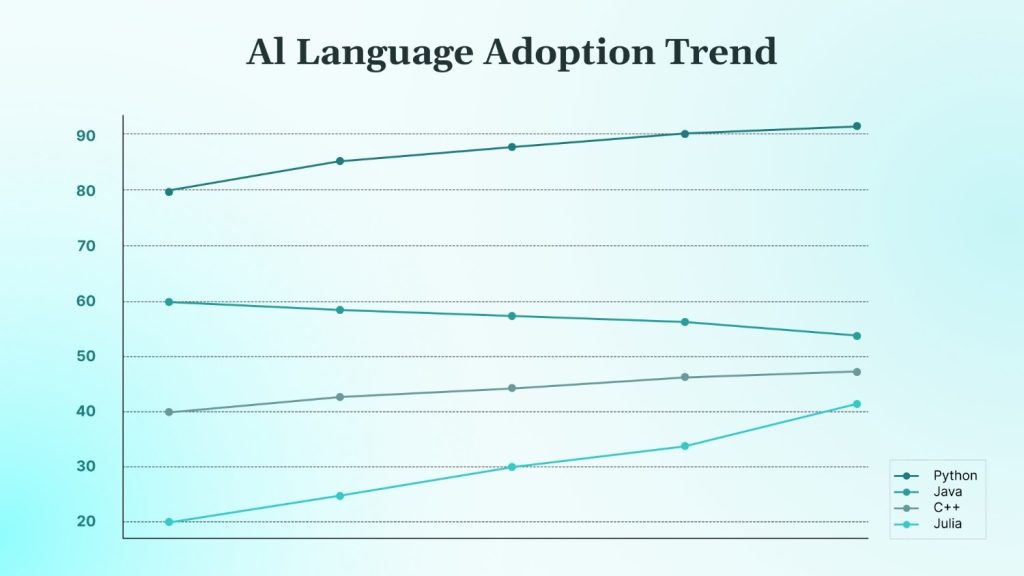
Selecting the right programming language for AI is about alignment with your product’s goals, technical requirements, and deployment environment. Each language brings unique capabilities to different types of AI workloads.
Below is a breakdown of commonly used AI languages and when to use them:
If you are just getting started:
- Go with: Python
- Why: It is readable, versatile, and packed with AI libraries like TensorFlow, PyTorch, and scikit-learn.
- Best for: Beginners, rapid prototyping, and building AI into web or cloud applications.
- Real-world use: DEVtrust often leverages Python in early-stage HealthTech and FinTech builds, where speed-to-market and iteration matter.
If you are building intelligent mobile apps:
- Go with: Java or Kotlin
- Why: JVM languages are stable, well-documented, and mobile-ready.
- Best for: AI-powered Android apps, backend integration, and financial or educational tools.
- DEVtrust insight: Used in EdTech and FinTech platforms for features like adaptive learning engines and fraud detection modules.
If performance is non-negotiable:
- Go with: C++
- Why: Maximum control over memory and speed, ideal for real-time processing.
- Best for: Robotics, autonomous systems, logistics tracking, and embedded AI.
- DEVtrust use case: C++ is often embedded within logistics tech projects to handle real-time shipment data and fleet tracking at scale.
If your work is heavy on data modeling and research:
- Go with: Julia
- Why: Built for high-performance numerical computing with built-in parallelism.
- Best for: Healthcare analytics, algorithmic trading, and custom AI research tools.
- Consideration: While DEVtrust typically prefers production-ready languages, Julia can support specialized AI experiments and proofs of concept.
Bottom Line:
The best language for AI depends on what you are solving for:
- Speed and hardware integration? C++.
- Developer productivity and ecosystem? Python.
- Mobile deployment? Java or Kotlin.
- High-performance computing? Julia.
At DEVtrust, technology choices are made based on system goals, not trends. Whether the objective is building a HIPAA-compliant AI assistant for clinicians or an adaptive learning platform for K–12, the programming language is selected to deliver secure, scalable, and maintainable results.
Explore how our AI/ML services align the right technologies with real-world business outcomes. From cloud-native deployments to mobile AI apps, we build intelligently at every layer.
Key Areas of Artificial Intelligence Application
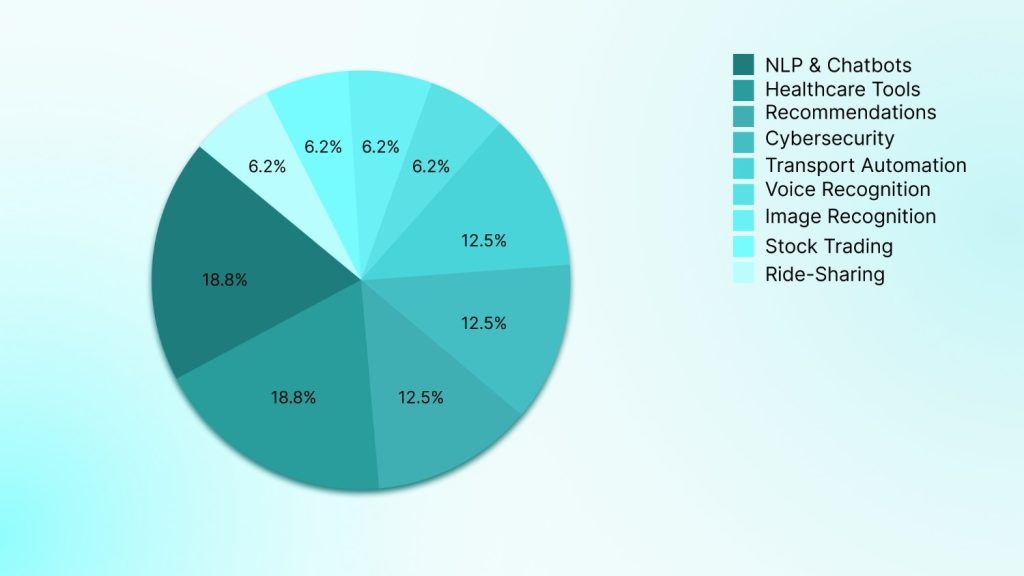
AI is not just shaping the future; It is already embedded in the systems we use every day. From voice-enabled devices to automated trading platforms, intelligent features are becoming a default expectation across sectors. Here is where AI is delivering real value:
1. Voice Recognition and Speech-to-Text
Speech-to-text technology powers voice-controlled assistants, smart remotes, in-car navigation, and accessibility tools. These systems convert spoken language into digital text, enabling hands-free experiences and real-time transcription.
Today’s applications go far beyond basic commands; modern systems adapt to accents, context, and even ambient noise. Tools like Speechnotes and ListNote are commonly used, but enterprise-grade apps often require custom STT integration.
Explore DEVtrust’s mobile app and backend services for secure, low-latency speech recognition features that work across devices and platforms.
2. Natural Language Processing (NLP)
NLP allows machines to interpret and respond to human language in a meaningful way. From chatbots to sentiment analysis engines, it is the technology behind tools that understand tone, intent, and nuance.
Applications range from customer support automation to clinical documentation tools that extract critical patient data in real time.
DEVtrust’s AI/ML teams have helped build intelligent assistants for healthcare, finance, and education, ensuring performance, security, and compliance at scale.
3. Image Recognition
AI-powered image recognition can detect, classify, and analyze objects, people, or actions from images and videos. It plays a vital role in security systems, medical diagnostics, retail inventory tracking, and autonomous vehicles.
In healthcare, it is used for medical image analysis; in logistics, for tracking damaged goods or verifying deliveries in real-time. High accuracy depends on well-trained models and edge-optimised deployment.
4. Intelligent Automation in Transport
Autopilot systems are not just for aviation anymore. AI is now used in driver-assist technology, fleet tracking, and predictive route optimization. By combining sensors, image recognition, and real-time data from GPS and logistics APIs, transport systems can operate more safely and efficiently.
5. Product Recommendations
E-commerce platforms rely heavily on AI to personalize shopping experiences. Algorithms process browsing history, purchase behavior, time of day, and even weather patterns to surface relevant suggestions in real time.
While off-the-shelf tools exist, customized models typically perform better, especially when integrated with unique customer data pipelines. This is where proprietary models and backend optimization matter.
6. Threat Detection and Cybersecurity
Spam filters and antivirus tools now use machine learning to identify malicious patterns, block phishing attempts, and isolate unknown threats. These systems evolve as new threats emerge, making them far more effective than static rule-based filters.
AI in cybersecurity also powers anomaly detection in finance and healthcare, helping institutions meet compliance standards while keeping systems secure.
7. Automated Stock Trading
AI algorithms are increasingly used in financial services to execute high-frequency trades, analyze market signals, and rebalance portfolios based on real-time risk. Tools like EquBot and Trade Ideas are examples, but most serious platforms now rely on custom-built trading engines.
8. On-Demand Mobility & Ride-Sharing
Ride-hailing services use AI to match passengers to drivers, calculate estimated arrival times, adjust pricing based on demand, and optimize routes on the fly. These systems depend on geospatial analytics, real-time traffic updates, and predictive modeling.
Our logistics tech team at DEVtrust develops intelligent backend systems for location tracking, automated dispatching, and fleet management, leveraging Google Maps API, AWS IoT Core, and FCM to power fast, reliable apps.
AI is no longer experimental. It is embedded in mission-critical systems across healthcare, finance, education, logistics, and consumer apps. The key is building it right, from the architecture and APIs to the performance and compliance layers.
DEVtrust: Real-World AI Language Expertise in Action
Choosing an artificial intelligence language is not just about syntax or community size; It is about how it performs under real-world conditions. At DEVtrust, we design and deploy AI-powered software across industries like healthcare, marketing, and enterprise SaaS, selecting the right language based on the specific goals, data, and infrastructure of each client.
Our teams work with Python for its unmatched flexibility in machine learning, but we also go beyond the obvious, leveraging JavaScript for browser-based AI, C++ for performance-critical systems, and Go for scalable backend pipelines. We do not push a one-size-fits-all stack. We match the language and architecture to your product’s needs, industry, and scale.
Where Language Choice Meets Real Impact
1. Elite Marketing Suite
To solve engagement bottlenecks on social platforms, DEVtrust developed a Chrome extension powered by NLP and machine learning. Python and JavaScript worked together, Python driving model logic and JavaScript handling in-browser AI experiences. The result?
- 65% less manual effort for marketers
- 70% better lead tracking through intelligent tagging
- 40% increase in user response rates with context-aware engagement tools
2. AI Assistant for Healthcare
For physicians drowning in documentation, we built a HIPAA-compliant AI tool that automates note-taking using OpenAI and Azure Speech-to-Text. Here, Python led the back end, handling medical NLP and secure SOAP note generation.
- Reduced documentation time by 60%
- 80% lower administrative overhead
- 100% data confidentiality maintained with healthcare compliance baked in
3. AI ChatBot for Document Intelligence
To streamline content extraction from PDFs, our team engineered a ChatBot using Python, Django, and OpenAI APIs. Built for rapid querying and natural Q&A over structured documents, this tool achieved:
- 90%+ accuracy in information retrieval
- 50% faster access to insights
- A modular, scalable design for future document expansion
At DEVtrust, artificial intelligence is not just a feature; It is part of the foundation. We help teams go beyond MVPs and deploy real, scalable solutions using the language that best fits their performance, data, and growth targets.
Conclusion
There is no single “best” artificial intelligence language, only the one that fits your project’s goals, your team’s strengths, and your product’s complexity. Python may be the go-to for most AI workloads, but languages like JavaScript, Go, Rust, and C++ all have their place depending on performance needs, deployment environments, and integration requirements.
The key is making smart choices early, ones that get the model working and also scale the product.
At DEVtrust, we work with teams across HealthTech, FinTech, EdTech, and beyond to build intelligent systems that are fast, flexible, and ready for the real world. From architecture to APIs, we help you pick the right stack and then deliver on it.
Get in touch with us and let us talk about what you are building.
Top Programming Languages for Artificial Intelligence
Explore top artificial intelligence languages like Python, Java, and C++ for scalable solutions. Boost your AI toolkit today. Click to learn more!
Contact Us